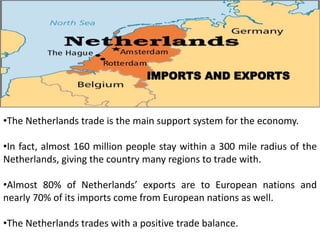
Netherlands
- 1. IMPORTS AND EXPORTS •The Netherlands trade is the main support system for the economy. •In fact, almost 160 million people stay within a 300 mile radius of the Netherlands, giving the country many regions to trade with. •Almost 80% of Netherlands’ exports are to European nations and nearly 70% of its imports come from European nations as well. •The Netherlands trades with a positive trade balance.
- 2. Netherlands Trade: Exports •Netherlands’ export volumes amounted to $397.6 billion in 2009, dropping from $531.7 billion in 2008. •The Netherlands ranked seventh in the world in terms of the export volumes. Its other export commodities are: Machinery and equipment Chemicals Fuel The Netherlands’ main export partners are: Germany Belgium France The UK Italy
- 3. Netherlands Trade: Imports •According to the 2009 statistics, the Netherland imported a total volume of $358.9 billion, dropping substantially from $474.8 billion in 2008. The Netherlands ranked eighth in the world in terms of import volumes. Other import commodities include: •Transport equipment Chemicals Fuels Clothing •The main import partners are: Germany China Belgium The US The UK Russia France
- 4. AGRICULTURE •The Dutch agricultural sector is highly mechanised, and has a strong focus on international exports. •It employs about 4% of the Dutch labour force but produces large surpluses for the food-processing industry and accounts for 21 percent of the Dutch total export value. •The Dutch rank second worldwide in value of agricultural exports, behind only the United States, with exports earning €80.7 billion in 2014, up from €75.4 billion in 2012.
- 5. The Netherlands has, at some time in recent history, supplied one quarter of all of the world's exported tomatoes, and trade of one-third of the world's exports of chilli's, tomatoes and cucumbers goes through the country. The Netherlands also exports one-fifteenth of the world's apples. Aside from that, a significant portion of Dutch agricultural exports consists of fresh-cut plants, flowers, and flower bulbs, with the Netherlands exporting two-thirds of the world's total.
- 6. NETHERLANDS BANKING •The most developed sector of the Dutch economy is the service field, with over 2/3 of GDP, which includes banking, insurance and transport. Four Dutch banks are rated in the top 60 world banks: ABN AMRO, ING and Fortis PABOBANK. •They have developed a network of approximately 6,500 branches throughout the Netherlands and 500 in other 50 countries. Meanwhile, in the Netherlands operates more than 60 subsidiaries and branches of banks in Europe, Asia and America. •The banking system in the Netherlands starts in 1814 when the De Nederlandsche Bank (DNB) was founded. •The banking system in the Netherlands is highly concentrated, being ranked in the top five banks accounting for a share of 86.8 % of total assets.
- 7. The banking system in the Netherlands includes the following banking institutions: commercial banks, savings banks, credit unions and mortgage banks. The most important banks in the Netherlands are ING Bank and ABN AMRO (consisting of Fortis, RBS and BSCH). The banking system in the Netherlands also includes a bank specializing in providing specialized products and services for individuals integrated into the post office – POSTBANK. In October 2004 DNB merged with the Bank of the Pension and Insurance Board (which in 2001 was named Insurance Board) DNB approval is required for the establishment of a pension fund or insurance company. This is given only if the fund or life insurer has sufficient financial resources and is led by specialists.